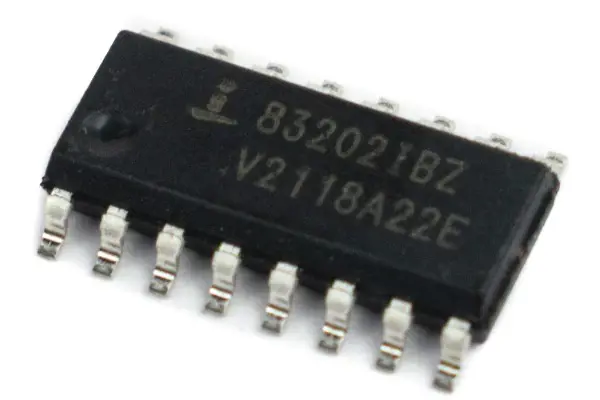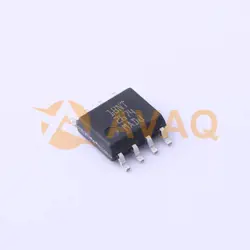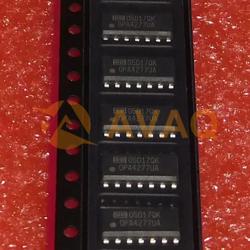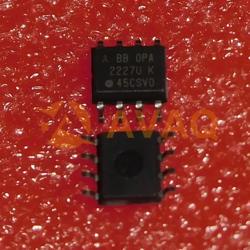NE5532 vs TL072: What are Differences and How to Choose 2023
 Published: Aug 18, 2023
Published: Aug 18, 2023
Contents
The NE5532 and TL072 are two prominent operational amplifiers (op-amps) that have earned their place in the world of electronics for their versatile performance and widespread applications. Op-amps are essential building blocks in analog circuitry, providing amplification, signal conditioning, and a myriad of other functions. While both the NE5532 and TL072 serve as reliable op-amps, they exhibit distinct characteristics that make them suitable for specific scenarios.
Understanding the differences between the NE5532 and TL072 is essential for making informed decisions when selecting the right op-amp for your project. In this article, we will delve into the distinctions between the NE5532 and TL072 op-amps, offering insights to help you navigate their unique features and choose the most suitable option for your analog circuit requirements.
Part 1. What is NE5532
This part includes the overview of NE5532, pinout, specification and features, circuit and application. Let’s explore it.
#1. NE5532 Overview
The NE5532 is a high-performance low-noise dual operational amplifier (dual op-amp) integrated circuit. It is similar to many standard op-amps, but it is characterized by better noise performance, excellent output drive capability and fairly high small-signal bandwidth with a wide supply voltage range. It is part of the NE55xx series of op-amps manufactured by Texas Instruments and Fairchild Semiconductor.
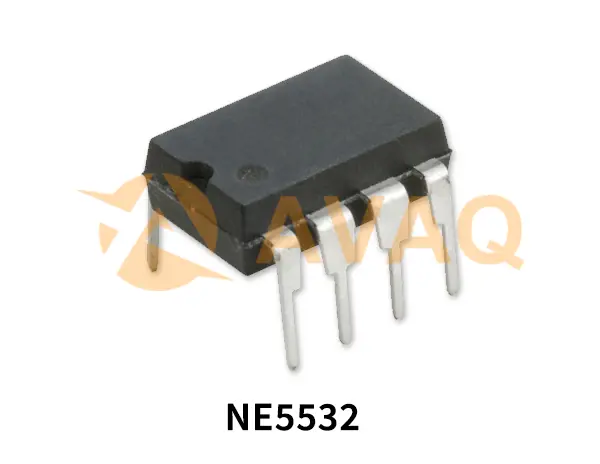
It is suitable for use in high quality and professional audio equipment, instruments, control circuits and telephone channel amplifiers. Used for audio amplification, warm tone, high fidelity, in the early nineties of the last century, the audio world is known as the audiophile "king of the op-amp", is still a lot of audio audiophiles in the hands of one of the necessary op-amp.
#2. NE5532 Pinout
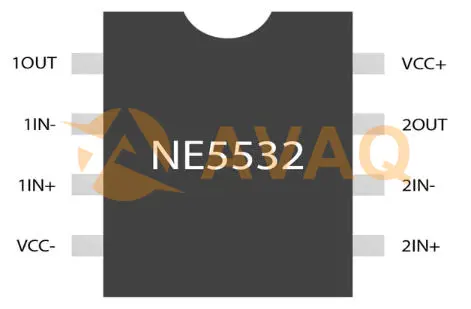
#3. NE5532 Specification and Features
|
Parameters |
No |
|
Number of channels |
2 |
|
Recommended Supply Voltage (V) |
±5-12 |
|
Gain bandwidth (MHz) |
10 |
|
Power bandwidth (KHz) |
140 |
|
Conversion rate (V/us) |
9 |
|
Input Offset Voltage (mV) |
5 (Max) |
|
Input noise voltage (nV/Hz) |
5 |
|
Common mode rejection ratio (dB) |
70 (Min) |
|
Static current (mA) |
8 |
Features
Low Noise: The NE5532 is designed for low input voltage noise, making it suitable for applications where minimizing noise is important, such as audio amplification.
Low Distortion: The op-amp is designed to provide low harmonic distortion, contributing to high-quality audio signal processing.
Wide Bandwidth: The NE5532 has a wide bandwidth, allowing it to handle a broad range of audio frequencies and other signals.
High Slew Rate: The high slew rate enables the op-amp to respond quickly to changes in input signals, maintaining signal accuracy in fast-changing applications.
High Open-Loop Gain: The op-amp has a high open-loop gain, which can be useful in applications requiring precise amplification and control.
Dual Op-Amp Configuration: Packaged as a dual op-amp, it offers two separate op-amp circuits within a single package, saving board space and cost.
Internally Compensated: The op-amp is internally compensated for stability, simplifying its use in various circuit configurations without requiring external compensation components.
Wide Supply Voltage Range: The NE5532 is designed to operate over a wide range of power supply voltages, enhancing its versatility in different circuit designs.
Compatible with Single or Dual Supply Operation: The op-amp can be used with a single positive power supply or a dual power supply, offering flexibility in circuit design.
Versatile Applications: Widely used in audio preamplifiers, headphone amplifiers, equalizers, mixers, and other audio-related circuits where high-quality signal processing is desired.
Package Options: Available in both DIP (Dual Inline Package) and surface-mount packages, catering to various PCB layout and assembly preferences.
#4. NE5532 Circuit
This is a novel OCL amplifier circuit with bootstrap effect, the circuit principle is shown in the attached figure, by the NE5532 (you can also use other op-amps) and two high-power NPN transistor composition.BG1/R4/R5/R6/R7 composition of the driving stage, where R4/R7 determines the gain of the back stage circuit.BG2/BG3/D1/D2/R8/R9/C7 constitute the output stage. stage.
The circuit is characterized by applying a certain voltage to the output tubes at static time, which puts them in a Class A bias state.
Debugging: Adjust R6 at static so that the collector voltage of BG3 is 0.6V.
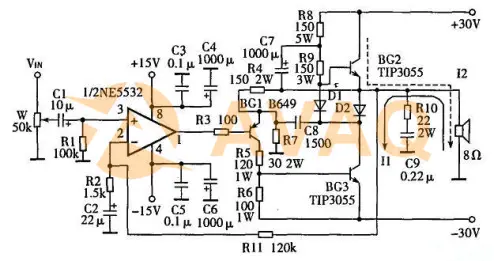
#5. NE5532 Application
- Audio preamplifiers
- Headphone amplifiers
- Equalizers and tone control
- Mixers and audio consoles
- Active filters and crossovers
- Instrumentation amplifiers
- Voltage followers and buffers
- Effects pedals (music)
- Active audio mixers
- Analog signal processing
- Audio line drivers
- Synthesizer circuits (VCAs)
#6. NE5532 Equivalent
TL072, TL1971, LM358, LM4558 and LM258.
Part 2. What is TL072
This part includes the overview of TL072, pinout, specification and features, and application.
#1. TL072 Overview
The TL072 is a widely used operational amplifier (op-amp) integrated circuit. An op-amp is an electronic component that amplifies the difference in voltage between two input terminals. The TL072 is specifically a dual op-amp, meaning it contains two separate op-amp circuits within a single package. It is part of the TL07x series of op-amps manufactured by Texas Instruments and other semiconductor companies.
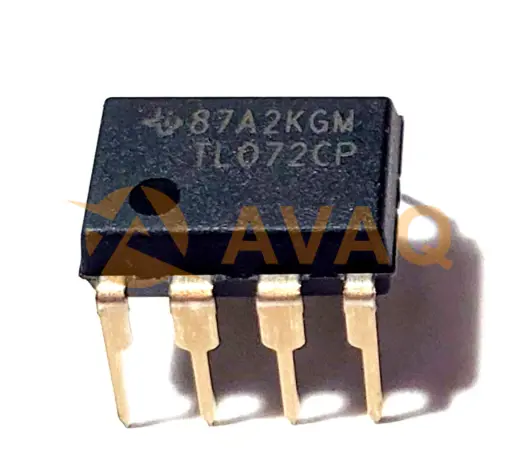
#2. TL072 Pinout
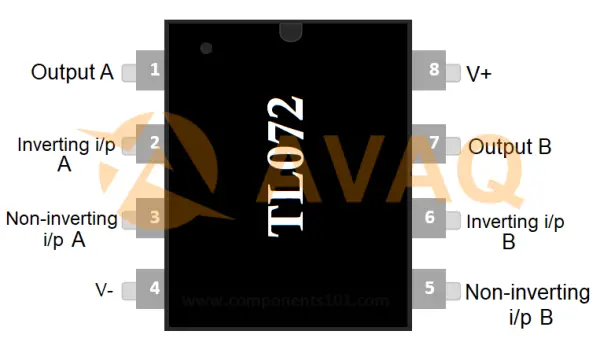
#3. TL072 Specification and Features
• High slew rate: 20 V/μs (TL07xH, typ)
• Low offset voltage: 1 mV (TL07xH, typ)
• Low offset voltage drift: 2 μV/°C
• Low power consumption: 940 μA/ch (TL07xH, typ)
• Wide common-mode and differential
voltage ranges
– Common-mode input voltage range
includes VCC+
• Low input bias and offset currents
• Low noise: Vn = 18 nV/√Hz (typ) at f = 1 kHz
• Output short-circuit protection
• Low total harmonic distortion: 0.003% (typ)
• Wide supply voltage: ±2.25 V to ±20 V, 4.5 V to 40 V
Features
Dual Op-Amp Configuration: The TL072 contains two separate op-amp circuits within a single package, providing versatility and efficiency in circuit design.
High Slew Rate: With a high slew rate of 20 V/μs (TL07xH, typical), the op-amp can respond quickly to rapid changes in input signals.
Low Offset Voltage: The op-amp offers a low offset voltage of 1 mV (TL07xH, typical), contributing to accurate signal amplification and minimizing errors.
Low Offset Voltage Drift: The low offset voltage drift of 2 μV/°C ensures stable performance over varying temperatures.
Low Power Consumption: It features low power consumption, with a typical current of 940 μA per channel (TL07xH, typical), contributing to energy-efficient designs.
Wide Common-Mode and Differential Voltage Ranges: The TL072 can operate over a wide range of common-mode input and differential voltages, enhancing its adaptability to different input signals.
Low Input Bias and Offset Currents: The op-amp exhibits low input bias and offset currents, which is essential for maintaining accuracy in signal processing.
Low Noise: It has low noise characteristics with Vn = 18 nV/√Hz (typical) at f = 1 kHz, making it suitable for applications where noise performance is critical.
Output Short-Circuit Protection: The op-amp is equipped with protection against output short-circuits, enhancing the durability of the circuit.
Low Total Harmonic Distortion (THD): The TL072 offers a low THD of 0.003% (typical), ensuring high signal fidelity and minimal distortion.
Wide Supply Voltage Range: It can operate over a wide supply voltage range, accommodating various power supply configurations.
#4. TL072 Application
- Audio Preamplifiers: Amplifying weak audio signals.
- Active Filters: Designing frequency-selective circuits.
- Instrumentation Amplifiers: Accurate measurement of small signals.
- Voltage Followers and Buffers: Signal isolation and buffering.
- Signal Generators: Producing different waveforms.
- Comparators: Comparing input voltages.
- VCAs: Controlling signal amplitudes in music.
- Signal Conditioning: Preparing signals for conversion.
- Active Mixers: Blending multiple signals.
- Voltage Regulators: Precise voltage control.
- Waveform Shaping: Modifying signal shapes.
- Active Rectifiers: AC to DC conversion.
- Logarithmic Amplifiers: Converting linear inputs to logarithmic outputs.
#5. TL072 Equivalent
Part 3. Differences between NE5532 VS TL072
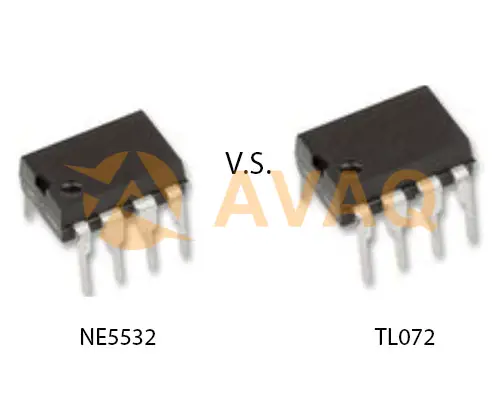
The NE5532 and TL072 are both operational amplifiers (op-amps), but they have some differences in terms of specifications and characteristics. Here are some key differences between the NE5532 and TL072:
|
Aspect |
NE5532 |
TL072 |
|
Noise Performance |
Low noise, suitable for audio |
Good noise performance |
|
Slew Rate |
Typically higher |
Lower |
|
Input Offset Voltage |
Typically slightly higher |
Generally lower |
|
Input Offset Voltage Drift |
Lower drift over temperature |
Higher drift |
|
Total Harmonic Distortion (THD) |
Low THD, good for audio |
Typically higher THD |
|
Common-Mode Rejection Ratio (CMRR) |
Generally higher CMRR |
Good CMRR |
|
Supply Voltage Range |
Narrower range |
Wider range |
|
Applications |
High-quality audio |
Various analog circuits |
How to Choose between NE5532 and TL072 (HOT!)
Choosing between the NE5532 and TL072 operational amplifiers (op-amps) depends on the specific requirements of your application. Here are some considerations to help you make an informed decision:
💎 Noise and Audio Quality:
If your application requires high-quality audio amplification, especially in audio preamplifiers or headphone amplifiers, the NE5532 is often preferred due to its lower noise and distortion characteristics.
💎 Bandwidth and Frequency Response:
If your application involves high-frequency signals or requires a wide bandwidth, the NE5532 might be a better choice, as it typically has a higher bandwidth and slew rate compared to the TL072.
💎 Power Supply Voltage:
Consider the power supply voltage available in your circuit. The NE5532 typically requires a higher minimum power supply voltage compared to the TL072. Choose the one that matches your available voltage range.
💎 Input Bias Current:
The TL072 generally has lower input bias current compared to the NE5532. If your application is sensitive to input currents, the TL072 might be more suitable.
💎 Cost and Availability:
Compare the cost and availability of both op-amps. In some cases, one op-amp might be more readily available or cost-effective than the other.
💎 Application Specifics:
Consider the specific requirements of your circuit. If you're designing filters, amplifiers, oscillators, or other circuits, review the datasheets of both op-amps to ensure that their specifications meet your needs.
💎 Noise Immunity and Signal Integrity:
The NE5532's lower noise levels can be advantageous in applications where noise immunity and signal integrity are critical, such as low-level sensor interfaces.
💎 Power Consumption:
If your application demands low power consumption, check the datasheets for the typical current consumption of each op-amp.
💎 Input and Output Voltage Range:
Verify that the input and output voltage ranges of the op-amp are compatible with your signal levels and requirements.
💎 Package and Pinout:
Ensure that the package type and pinout of the chosen op-amp are suitable for your circuit layout and design.
In summary, choose the NE5532 if you prioritize low noise, high audio quality, and wide bandwidth. Choose the TL072 if you need lower input bias current, flexibility in single-supply applications, or if it meets your specific requirements while keeping costs in check.
Part 4.NE5532 and TL072 Datasheet PDF
🛡Click and Download NE5532 Datasheet PDF here>>
🛡Click and Download TL072 Datasheet PDF here>>
Conclusion
In conclusion, the choice between the NE5532 and TL072 op-amps hinges on the specific needs of your analog circuit design and performance expectations. The NE5532 offers superior audio performance and low noise, making it an excellent choice for high-fidelity audio applications. On the other hand, the TL072 is prized for its versatile performance, wide bandwidth, and compatibility with a range of applications.
When selecting between the NE5532 and TL072, consider factors such as noise requirements, bandwidth, voltage supply, and the intended application. Stay updated with the latest developments in op-amp technology, explore technical documentation, and experiment with different circuit configurations to harness the full potential of these op-amps in your projects. Whether you are designing audio equipment, signal conditioning circuits, or precision instrumentation, the choice between the NE5532 and TL072 will shape the quality and performance of your analog circuitry, enabling you to create designs that meet your specific requirements with precision and excellence.
 FAQ
FAQ
- Can I use the NE5532 or TL072 in single-supply circuits?
- Yes, both op-amps can be used in single-supply circuits. However, additional circuitry may be required to bias the inputs correctly and provide proper output swing.
- Are there other alternatives to the NE5532 and TL072?
- Yes, there are many other op-amp options available, each with its own set of specifications and characteristics. Some alternatives include the LM358, LM741, and OPA2134.
- Can I substitute one op-amp for the other?
- In many cases, you can substitute one op-amp for the other if the specifications and requirements of your circuit allow for it. However, differences in noise, bandwidth, and other characteristics may affect the performance.
- Which op-amp is better for audio applications?
- The NE5532 is often preferred for high-quality audio applications due to its lower noise and distortion characteristics.
NE5532DR In Stock: 6374 $0.114
 Popular Industry Focus
Popular Industry Focus
Hot Products
-
![INA828IDR]()
INA828IDR
TI
Instrumentation Amplifier 1 Circuit 8-SOIC
-
![LM2674MX-ADJ/NOPB]()
LM2674MX-ADJ/NOPB
TI
SIMPLE SWITCHER® 40V, 500mA Low Component Count Step-Down Regulator
-
![OPA171AIDR]()
OPA171AIDR
Texas Instruments
The OPA171AIDR offers superior accuracy and stability, making it a reliable choice for demanding circuit designs
-
![TPS2001CDGNR]()
TPS2001CDGNR
Texas Instruments
Power Switch ICs - Power Distribution Single Channel
-
![CSD19532Q5BT]()
CSD19532Q5BT
Texas Instruments
Product CSD19532Q5BT, also known as VSON-8-EP(5x6) MOSFETs ROHS, is characterized by its compact VSON-8-EP(5x6) packaging design
-
![TPS73533DRBR]()
TPS73533DRBR
TI
Linear Voltage Regulator IC Positive Fixed 1 Output 500mA 8-SON (3x3)
Related Parts
-
![INA828IDR]()
INA828IDR
TI
Instrumentation Amplifier 1 Circuit 8-SOIC
-
![OPA171AIDR]()
OPA171AIDR
Texas Instruments
The OPA171AIDR offers superior accuracy and stability, making it a reliable choice for demanding circuit designs
-
![OPA4277UA]()
OPA4277UA
Texas Instruments
The OPA4277UA is an operational amplifier IC featuring 4 channels
-
![OPA2227U]()
OPA2227U
Texas Instruments
The SOIC-8 package of OPA2227U is compliant with the ROHS directive for reducing hazardous materials
-
![OP177FS]()
OP177FS
ADI
OP-AMP, 40uV OFFSET-MAX, 0.6MHz BAND WIDTH, PDSO8, MS-012AA, SOIC-8
-
![MAX4016ESA+]()
MAX4016ESA+
ADI
Voltage Feedback Amplifier 2 Circuit Rail-to-Rail 8-SOIC
-
![MAX4173TESA]()
MAX4173TESA
ADI
Current Sense Amplifiers V-Out High-Side Current-Sense Amp
-
![AD8041AR]()
AD8041AR
ADI
Voltage Feedback Amplifier 1 Circuit Rail-to-Rail 8-SOIC
-
![LM741CN]()
LM741CN
Texas Instruments
Operational Amplifier General Purpose 1 Circuit
-
![TLV272IDGKR]()
TLV272IDGKR
TI
Dual, 16-V, 3-MHz operational amplifier
-
![LM358P]()
LM358P
Texas Instruments
20nA Dual 700kHz DIP-8 Operational Amplifier ROHS
-
![LF351DT]()
LF351DT
ST
JFET inputs, low input bias & offset current, (15nV/sqrtHz & 0.01%)
-
![AD8574ARZ]()
AD8574ARZ
ADI
Zero-Drift, Single-Supply, RRIO Quad Op Amp
-
![OP297GPZ]()
OP297GPZ
ADI
Low Bias Current Precision (Dual) Operational Amplifier
-
![OP196GSZ]()
OP196GSZ
ADI
Op Amp Single Micropower Amplifier R-R I/O 12V 8-Pin SOIC N Tube

 Update Time: Aug 21, 2023 Consumer Electronics
Update Time: Aug 21, 2023 Consumer Electronics
